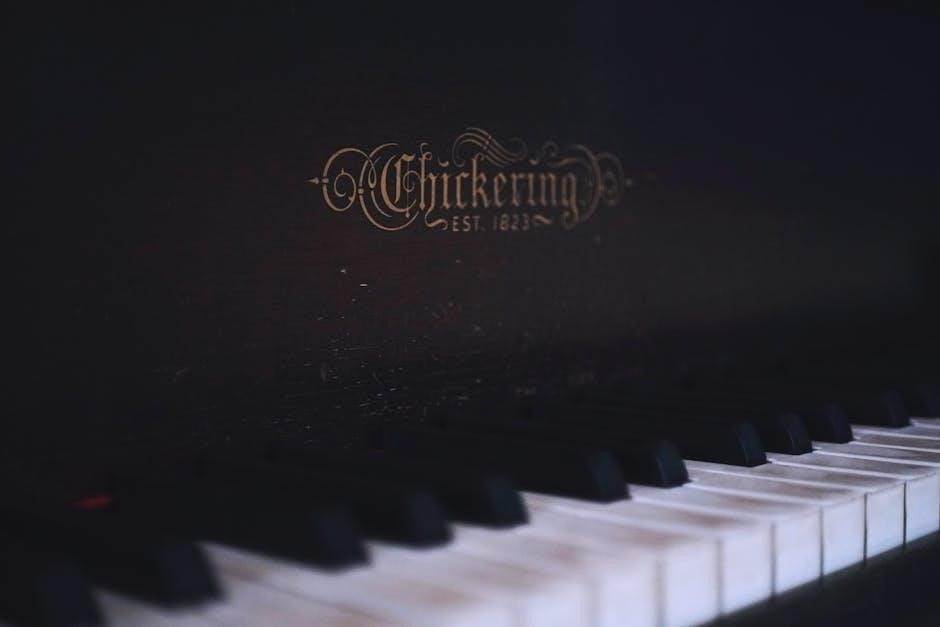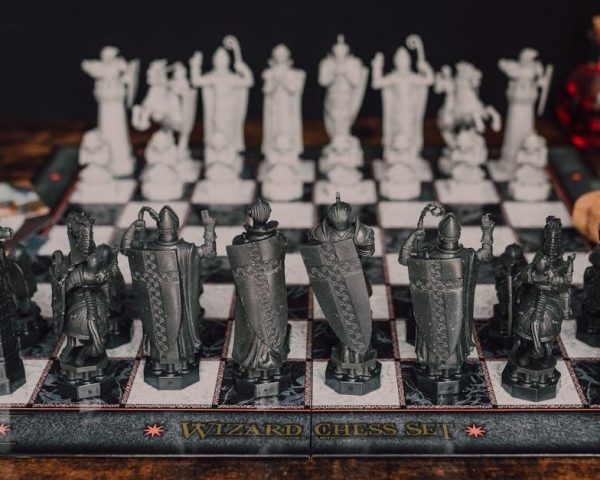Jazz piano chords are essential elements in creating harmonic foundations for improvisation and accompaniment. These chords, often extended with 7ths, 9ths, or 11ths, add color and emotion to music. Understanding their structure and function is crucial for any pianist aiming to master jazz. Whether you’re composing, improvising, or accompanying, jazz chords provide the harmonic backbone of modern music, offering endless possibilities for expression and creativity.
From basic triads to complex voicings, jazz chords are built using tertian harmony, with each note spaced by thirds. This foundational concept allows pianists to create rich, layered sounds. By exploring these chords, musicians can elevate their playing, adding depth and sophistication to their performances. Jazz chords are not just technical exercises but tools for storytelling through music, making them indispensable for any serious pianist.
1.1 Understanding the Basics of Jazz Chords
Jazz chords are built using tertian harmony, with each note stacked in thirds. A basic triad consists of a root, third, and fifth, forming major, minor, or diminished chords. Jazz extends these by adding 7ths, 9ths, 11ths, and 13ths, creating richer, more complex sounds; Understanding these extensions is key to mastering jazz harmony. The 7th chord, for example, adds a note that defines the chord’s quality as major, minor, or dominant. Scales, such as the major and harmonic minor, are also fundamental, as they provide the notes used in chord construction. Grasping these basics allows pianists to build and improvise with confidence, forming the foundation of jazz piano playing.
Learning chord symbols and their functions is equally important. Symbols like Cmaj7, C7, and Cm7 indicate specific chord qualities. By recognizing these, pianists can interpret sheet music and lead sheets effectively. Additionally, understanding chord progressions, such as the ii-V-I, helps in creating cohesive harmonic structures. These basics are essential for any pianist aiming to excel in jazz, providing the tools to express emotions and tell stories through music.

Best Exercises to Master Big Jazz Piano Chords
Mastering big jazz piano chords requires consistent practice of scales, arpeggios, and chord progressions. Start with rootless voicings and gradually incorporate extensions like 9ths and 11ths for depth.
Focus on exercises that emphasize hand independence, finger strength, and harmonic clarity. Practicing block chords and one-handed voicings can help build precision and control over complex harmonies.
2.1 Building Big Jazz Piano Chords: A Step-by-Step Guide
Building big jazz piano chords begins with understanding their structure. Start with basic triads, then add 7ths, 9ths, and 11ths to create richer sounds. Focus on rootless voicings to avoid muddiness in the lower register. Practice drop-2 and drop-3 techniques to spread chords evenly across the keyboard. Use scales and arpeggios to identify chord tones and extensions. Begin with slow tempos and gradually increase speed as comfort grows. Emphasize harmonic clarity by ensuring each note rings out distinctly. Finally, practice chord progressions in all keys to build versatility and muscle memory. Regular practice with a metronome will help refine your timing and precision.
2.2 Essential Exercises for All Skill Levels
Mastering jazz piano chords requires consistent practice. Begin with simple exercises like playing chords in all keys, focusing on smooth transitions. Use a metronome to improve timing and dexterity. For foundational skills, practice scales and arpeggios to strengthen finger independence and chord tone accuracy. Intermediate players can explore drop-2 and drop-3 voicings to enhance harmonic clarity. Advanced exercises include improvising over chord progressions and experimenting with substitutions. Start with slower tempos and gradually increase speed as confidence grows. Incorporate blues and standard progressions to apply chords in real-world contexts. Regular practice with these exercises will build strength, precision, and musicality, preparing you for complex jazz performances.
Downloadable Jazz Piano Chord Resources
Discover high-quality PDF resources for jazz piano chords, including detailed chord charts, progressions, and tutorials. These files offer comprehensive guides for mastering jazz harmony and improvisation techniques.
3.1 Top PDF Files for Jazz Piano Chords and Progressions

Explore a wide range of downloadable PDF files designed to help pianists master jazz chords and progressions. These resources include detailed chord charts, scales, and exercises tailored for all skill levels. From basic 7th chords to complex extended voicings, these PDFs provide a comprehensive guide to understanding jazz harmony. Many files also cover essential progressions, such as the minor 251 sequence, in all 12 keys. Additionally, some resources offer printable transcriptions of tutorials and lessons, making it easier to practice and apply concepts. Whether you’re a beginner or an advanced player, these PDFs are invaluable tools for improving your jazz piano skills.
3.2 Where to Find High-Quality Jazz Piano Tutorials and Lessons
Discover exceptional jazz piano tutorials and lessons from reputable online platforms. Websites like InsidePiano offer video tutorials and downloadable PDFs, while bushgrafts.com provides printable transcriptions for in-depth practice. Berklee College of Music offers free online lessons, perfect for expanding harmonic knowledge. Additionally, resources like jazzpotes2.free.fr and Piano Chord Voicing Mnemonics cater to advanced techniques. These platforms deliver structured lessons, interactive exercises, and expert guidance, ensuring a comprehensive learning experience. Whether you’re a beginner or an advanced pianist, these resources are designed to enhance your jazz piano skills effectively.

Jazz Piano Chord Voicings
Jazz piano chord voicings offer a variety of techniques to enhance harmonic expression. From one-handed voicings to block chords, these methods add texture and emotion to your playing, guiding improvisation and ensuring harmonic clarity.
4.1 Mastering One-Handed Jazz Voicings
Mastering one-handed jazz voicings is essential for pianists seeking versatility and harmonic clarity. These voicings focus on condensing chords into manageable shapes, emphasizing the 3rd and 7th for rich, full sounds. Start by familiarizing yourself with rootless voicings for major 7, dominant 7, and minor 7 chords, using mnemonics to simplify learning. Practice voicings in all keys, beginning with Category A (3rd in the lowest voice) for consistency. Gradually incorporate alterations and extensions to add color. Begin with simple voicings, then explore more complex structures as your skills grow. Regular practice with scales and arpeggios will strengthen your ability to apply these voicings effectively in improvisation and accompaniment. This technique is vital for achieving a professional jazz sound, enabling you to convey harmonic depth with precision and flair.
4.2 Block Chord Techniques for Jazz Piano
Block chord techniques are a cornerstone of jazz piano, offering a powerful way to harmonize melodies and create cohesive, rhythmic playing. These techniques involve playing all notes of a chord simultaneously, often in a locked-hand style. Start by practicing block chords in a slow, deliberate manner, focusing on clarity and evenness. As you progress, incorporate rhythmic variations, such as syncopation and accents, to add vitality. Begin with simple block chords in the key of C minor, gradually expanding to other keys. Modulations and out-of-key techniques can be introduced to enhance harmonic interest. Regular practice with scales and arpeggios will strengthen your ability to execute these chords smoothly, making them a dynamic addition to your jazz repertoire. This method is essential for developing a polished, professional sound.

Jazz Chord Progressions
Jazz chord progressions are the harmonic backbone of jazz, creating movement and emotion. Common progressions like the ii-V-I are essential for establishing harmonic structure and guiding improvisation.
5.1 Common Jazz Progressions in All Keys
Mastering jazz chord progressions requires familiarity with key structures. The ii-V-I progression is a cornerstone, appearing in all keys and forming the basis of countless standards. Minor and major keys each have distinct progressions, such as the iii-vi-ii-V in minor keys, which add variety. These harmonic sequences are versatile, allowing for endless variations through substitutions and alterations. Practicing these progressions in all keys enhances your understanding of tonal harmony and expands your improvisational palette. By internalizing these patterns, you can navigate complex compositions with confidence and create compelling solos that align with the harmonic framework.

5.2 Practicing Chord Progressions with Tensions
Practicing chord progressions with tensions enhances harmonic richness and emotional depth. Tensions, such as 9ths, 11ths, and 13ths, add color to chords, creating complex sounds. Start by identifying the chord tones and then explore extensions within scales. For example, a major chord can include a 9th or 11th, while a dominant 7th often features a 9th or altered tones. Use these tensions selectively to maintain harmonic clarity. Practice progressions like the ii-V-I with extended voicings, focusing on smooth transitions. Record yourself and analyze the emotional impact. Over time, these exercises will refine your harmonic vocabulary, allowing you to express nuanced ideas in your playing. Mastery of tensions is key to authentic jazz expression.

Scales and Chord Tones for Jazz Improvisation
Scales provide the melodic foundation, while chord tones offer harmonic structure. Understanding both is crucial for creating meaningful improvisations that connect melody and harmony seamlessly in jazz.

6.1 The Role of Scales in Jazz Chord Construction
Scales are the building blocks for constructing jazz chords, providing the notes and intervals that define chord structures. Major, minor, and modal scales are frequently used in jazz to create harmonies. By understanding how scales relate to chords, pianists can build extended chords like 7ths, 9ths, and 11ths. This connection allows for rich, complex voicings that are fundamental to jazz. Scales also guide improvisation, ensuring melodies align with underlying harmonies. Mastery of scales enhances a pianist’s ability to create and improvise within jazz chord progressions effectively.
6.2 Using Chord Tones for Effective Improvisation
Chord tones are the foundational notes of a chord and serve as the harmonic backbone for improvisation. By focusing on these tones, pianists can create melodic lines that align with the underlying harmony, ensuring coherence and emotional impact. In jazz, chord tones provide a structural framework, allowing for creative expression while maintaining harmonic clarity. Whether playing over complex progressions or simple vamps, chord tones guide the improviser, helping to build tension and resolution effectively.
Practicing chord tones in all keys strengthens a pianist’s harmonic awareness, enabling them to navigate chord changes with confidence. This skill is vital for crafting meaningful solos and for accompanying other musicians seamlessly in a jazz setting.

Jazz Piano Tutorials and Lessons
Explore comprehensive online tutorials and lessons designed to enhance your jazz piano skills. Resources like Berklee’s free music lessons and interactive tools offer structured learning for all levels, ensuring a deep understanding of jazz techniques and theory. These tutorials provide practical exercises, chord progressions, and improvisation tips, helping you master the art of jazz piano with clarity and precision.
7.1 Recommended Online Resources for Learning Jazz Piano
Discover exceptional online resources to master jazz piano. Berklee College of Music offers free lessons, providing foundational knowledge for jazz theory and improvisation. Websites like jazzpotes2.free.fr and pianoandvoicewithbrenda.com feature method books and exercises. Dan Haerle’s Jazz Piano Voicing Skills is a highly recommended resource for advanced voicing techniques. Additionally, platforms like InsidePiano offer video tutorials and downloadable PDFs for chords and progressions. These resources cater to all skill levels, ensuring a comprehensive learning experience. From beginner-friendly tutorials to advanced improvisation guides, these tools will enhance your understanding and performance of jazz piano.
Utilize these resources to explore chord voicings, scales, and improvisation strategies. Many sites provide printable materials and interactive lessons, making learning jazz piano accessible and engaging. Consistent practice with these tools will help refine your skills and deepen your appreciation for jazz music.


